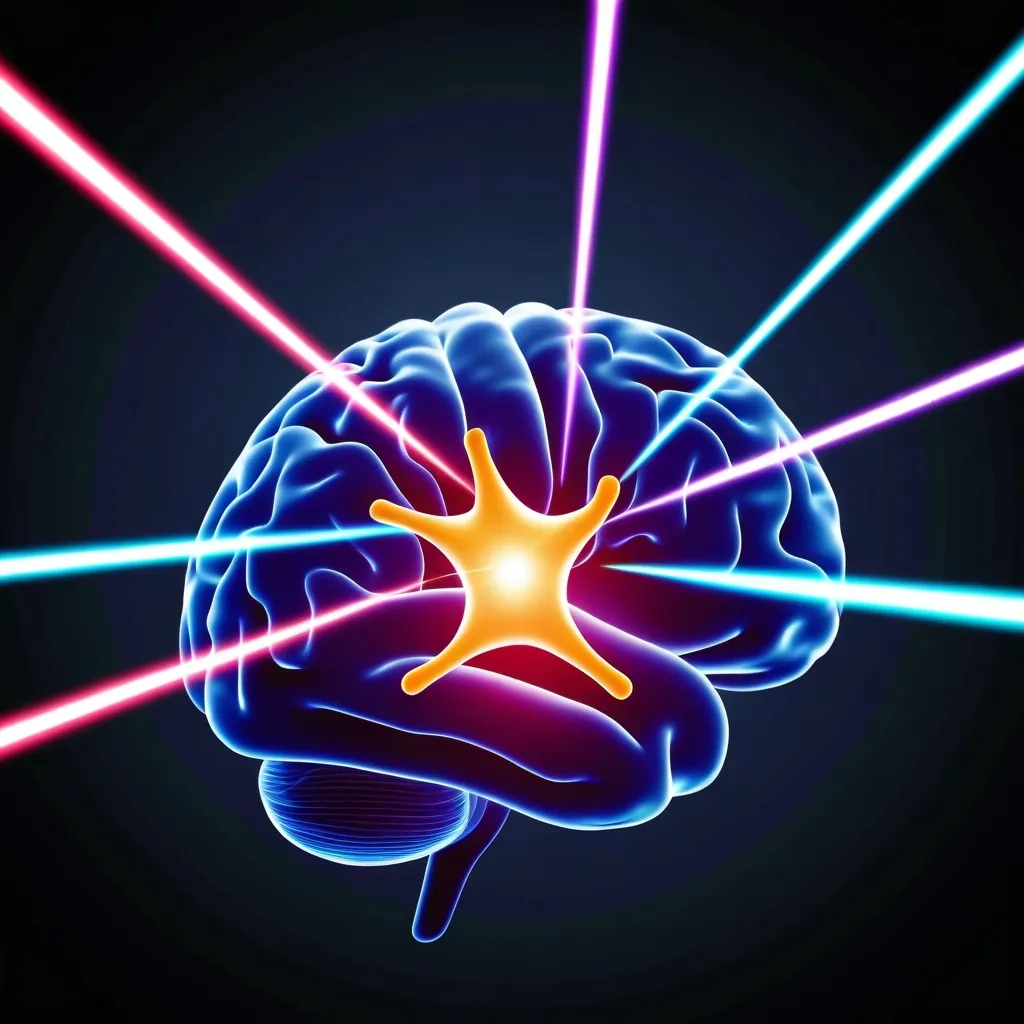Illuminating the Brain: The Optogenetics Revolution
Imagine being able to control specific brain cells with nothing more than a beam of light. It sounds like science fiction, but it’s actually cutting-edge science. Welcome to the world of optogenetics, a groundbreaking field that’s reshaping our understanding of the brain and offering new hope for treating neurological disorders.
Optogenetics is like having a light switch for your neurons. By combining genetics and optics, scientists can now control brain cells with unprecedented precision. It’s a game-changer in neuroscience, opening up possibilities we could only dream of a few decades ago.
So how does it work? Well, it all starts with some special proteins called opsins. These light-sensitive proteins are found in visual systems across the animal kingdom. Scientists figured out how to introduce these proteins into specific brain cells, making them responsive to light. It’s like giving neurons their own personal dimmer switch.
The real magic happens when you shine light on these modified neurons. Depending on the type of opsin used, you can either excite or inhibit the neuron’s activity. And we’re talking millisecond precision here. It’s like conducting a neural orchestra where you can control each instrument individually.
This level of control is a big deal. Traditional methods of brain stimulation are like trying to play a piano with boxing gloves on - you might hit the right notes, but you’ll probably hit a bunch of wrong ones too. Optogenetics, on the other hand, lets you tickle the ivories with the finesse of a concert pianist.
Let’s talk about some real-world applications. Take hearing loss, for example. Current cochlear implants use electrical stimulation, which can be a bit hit-or-miss. But with optogenetics, we could potentially create optical cochlear implants that offer much better sound quality. It’s like upgrading from an old transistor radio to a high-end stereo system.
Or consider vision problems. There’s a nasty eye disease called retinitis pigmentosa that can lead to blindness. Scientists are now exploring ways to use optogenetics to make certain eye cells light-sensitive again. In early trials, some patients who were essentially blind were able to perceive light again. It’s not perfect vision, but it’s a huge step forward.
Chronic pain is another area where optogenetics could make a big difference. By targeting specific pain-related neurons, we might be able to provide relief without the side effects of traditional pain medications. It’s like having a precision-guided missile for pain, instead of carpet-bombing your whole system with drugs.
And let’s not forget about Parkinson’s disease. This devastating condition affects millions worldwide, causing tremors and difficulty with movement. Optogenetics could offer a more precise way to manage these symptoms by controlling specific brain circuits involved in motor control. It’s like having a fine-tuned remote control for your brain’s motor functions.
Now, I know what you’re thinking. This all sounds great, but how do you actually get light into someone’s brain? It’s a fair question, and it’s been one of the big challenges in the field. Initially, scientists had to implant optical fibers directly into the brain - not exactly a comfortable solution for patients.
But here’s where things get really exciting. Recent advances have led to the development of super-sensitive opsins that can respond to light even when it’s diffused through the skull and brain tissue. There’s one called ChRmine that’s so sensitive, even a faint pulse of light can control neural activity. This means we might be able to control brain activity without invasive procedures. It’s like having X-ray vision for your brain, but with light instead of X-rays.
Of course, as with any new medical technology, there are ethical and safety considerations to keep in mind. We’re talking about modifying genes and potentially implanting light sources in the brain. These aren’t things to be taken lightly (pun intended). But the potential benefits are so massive that it’s definitely worth continuing to explore and refine these techniques.
The really mind-blowing thing about optogenetics is that it’s not just a treatment tool - it’s also an incredible research tool. By controlling specific neurons and observing the effects, scientists can gain deep insights into how the brain works. They’ve used it to artificially create memories in mice, study pain signals, and even reverse depression in animal models. It’s like having a universal programming language for the brain.
Just imagine the possibilities. A person with severe epilepsy could have their seizures controlled by a small, non-invasive device that shines light into their brain. Someone with Parkinson’s could manage their symptoms with a light-emitting headset. These aren’t just pipe dreams - they’re potential realities that optogenetics is bringing within reach.
And who knows what other applications we might discover? Could we use optogenetics to enhance memory or cognitive function? To treat mental health disorders? To interface more directly with computers? The possibilities are limited only by our imagination and our ability to ethically and safely implement these technologies.
Optogenetics is more than just a cool scientific trick. It’s a powerful tool that’s helping us unravel the mysteries of the brain and offering new hope for millions of people with neurological disorders. It’s a shining example (sorry, couldn’t resist) of how combining different scientific disciplines can lead to breakthroughs we never thought possible.
As we continue to explore and refine optogenetic techniques, we’re likely to see even more innovative applications. We’re at the dawn of a new era in neuroscience, where we can interact with the brain in ways that were once the stuff of science fiction.
So the next time you flip a light switch, take a moment to appreciate the incredible possibilities that light holds. Not just for illuminating our homes, but for illuminating the most complex and mysterious organ in our bodies - our brains. The future of neuroscience is bright indeed, powered by the incredible potential of optogenetics.
In the end, optogenetics is more than just a scientific advancement. It’s a beacon of hope for millions of people suffering from neurological disorders. It’s a key that’s unlocking the secrets of our minds. And it’s a testament to human ingenuity and the power of scientific curiosity. As we continue to push the boundaries of what’s possible with optogenetics, we’re not just shining a light on the brain - we’re illuminating the future of human health and understanding.






